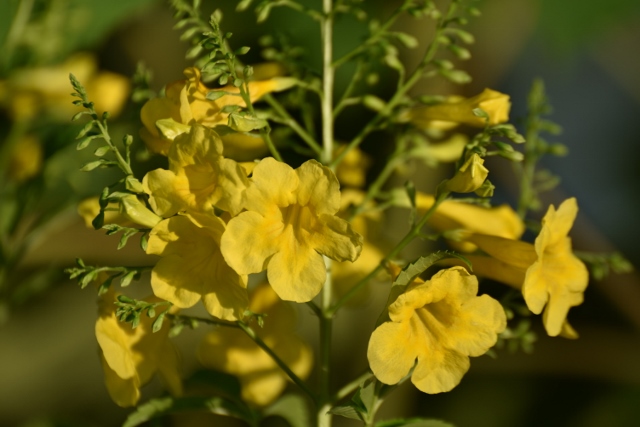By Anita Westervelt, Texas Master Naturalist

The air will soon be aflutter with masses of colorful butterflies searching for colorful flowers and rich nectar sources.
One popular Valley shrub coming into its showiest season is Esperanza (Tecoma stans). This prolific bloomer sports attention-getting, bright yellow clusters of bell-shaped flowers.
The eye-catching blooms aren’t just for looks — they attract butterflies and hummingbirds, bees and other insects. A lizard or two can probably be found hiding amongst the foliage, awaiting a tasty insect snack.
Esperanza also goes by yellow bells and sometimes yellow elder. It is native in south Texas and west to Arizona, south through Mexico and Central America to South America and northern Argentina, as well as in southern Florida and through much of the Caribbean.
The shrub grows in a rather irregular shape, but showy none the less, due to the large flower clumps that grow at the ends of branch tips. It can grow to six to eight feet tall with a three to four foot spread. Esperanza is heat-loving, drought-tolerant and nearly maintenance free.

Esperanza blooms from April through winter and most heavily in fall. Plant in full sun to get the most blooms. It tolerates a variety of soil types as long as the soil is well drained. Allow the soil to dry out between watering.
Esperanza can be trained as a single trunk, small tree. As such, they are popular as a median or street tree or near a patio. Untrained, they will become a bushy shrub, useful in a privacy border in residential neighborhoods and attractive in parking lot islands. Esperanza is an important addition to a butterfly garden because of its lengthy bloom period. The somewhat erratic growth can be trimmed to control shape, if desired.
The bright green leaves provide a great background to the curvy-shaped bells. The leaves are medium-sized, tooth-edged and dagger-like. In plant morphology, the leaves are said to be lanceolate — having the shape of a lance head and tapering to a point. Plant morphology is the study of the physical form of a plant, an important technique to the visual identification of plants.
Esperanza is best trimmed before it begins blooming in spring. The tree or shrub will benefit from an application of a general-purpose garden fertilizer before new growth begins to emerge in late winter or early spring. Water the ground well before applying fertilizer. Fertilizer can be reapplied every four to six weeks until the tree quits blooming in winter. A two to three inch layer of mulch can be applied during the fall. Leave the soil clear several inches around the base of the trunk.
Esperanza is easy to propagate. The flowers are followed by narrow, bean-like seed pods. Collect pods once they are no longer green, in late summer and fall. The seeds are papery and winged.
Esperanza is not only an important nectar plant but also a larval host to dogface butterflies and the Plebeian sphinx moth whose caterpillars hide during the day and feed at night.